- Home
- Barbara Ehrenreich
For Her Own Good: Two Centuries of the Experts Advice to Women Page 2
For Her Own Good: Two Centuries of the Experts Advice to Women Read online
Page 2
There is another way this book differs from many in the feminist myth-busting genre. We were not content to poke holes in ridiculous theories and obviously self-serving advice—which was easy enough to do. Instead we wanted to understand why the supposed experts propagated such theories and, more importantly, why so many women bought the advice. The late-nineteenth-century period in which our story begins was a time of great promise for women, and especially for the increasingly educated women of the middle class. More and more of the tasks that had absorbed women in the home—the manufacture of clothing, for example, and the preparation of food “from scratch”—were being taken over by industry, potentially freeing women for other pursuits. So why at such a moment of burgeoning possibilities did the experts propound, and so many women accept, the strictures of a life devoted to domesticity?
Our answer, spelled out in Chapter 1, departs even from feminist orthodoxy. In the common and still prevailing feminist view, the “domestication” of women represents the work of an ancient system of power—patriarchy—that finds one way or another to reproduce itself throughout the ages. Our research suggested a very different interpretation: it was not the persistence of patriarchy but the undermining of it that opened up the reign of the experts. Industrialization, urbanization, and the growth of the market economy in the late nineteenth and twentieth centuries disrupted traditional gender relations and raised unsettling questions: if a woman could earn a living on her own in the capitalist marketplace—as a few were beginning to do—why should she accept the financial dependency of traditional marriage? If she did not need to spend the day baking bread or boiling water for laundry, what was her mission in life? What did it mean to be female—and feminine—in a world no longer so clearly demarcated by biological differences in musculature and height? Anxiety suffused these questions, and the experts were ready with answers that grew out of their own anxieties in the face of rapid, unpredictable social change.
Since we wrote this book, much has changed, most of it unambiguously for the better. As women’s rights activists, we take pride in noting that some of the themes of this book are now of historical interest only. For example, we can no longer speak of the persistent sexism of a male-dominated medical profession: women now account for about a quarter of the nation’s doctors, and they are not as likely to promote myths of female frailty or masochism. And although “expert” advice on all matters domestic and personal continues to rain down on us, today much less of it directs women toward a traditional, domestic role. In fact, in Chapter 8, we trace a switch that was just beginning in the seventies—away from the idealization of the full-time homemaker and toward new values of independence and, at the extreme, selfish individualism for women as well as men. We discuss these shifts—the surge of women into the work force and the new expectation that they will be as ambitious as men—in the afterword. But for now it’s worth noting that, for all these changes, the onslaught of pseudoscientific theory and advice continues. A few recent examples include:
• Myths about the dangers of divorce: divorce is seldom a desirable experience for children, but some “experts” have promoted gross exaggerations of its long-term effects on them. In 2000, a prominent psychologist published a study purporting to show that the children of divorce were, as adults, usually deeply troubled and neurotic individuals. The implication was clear: stick with that unhappy marriage for the children’s sake. But as critics pointed out, this psychologist’s methodology was so badly flawed as to seem deceptive.
• Myths about breast cancer: antiabortionists have long claimed that abortion is a risk factor for breast cancer, although there is no evidence whatsoever for such a conclusion. Or we might mention the seemingly benign notion that a “positive attitude” can improve one’s chances of surviving that disease. One very small study had suggested as much, leading to a kind of blame-the-victim mentality in the treatment of late-stage breast cancer: if the treatments don’t work, it must be because you have a bad attitude. More recent studies found no such attitudinal effects on survival, although this news seems not to have reached all the relevant practitioners.
• Myths about women’s evolutionary role and biological heritage: starting in the late 1960s, “sociobiologists” promoted an evolutionary theory in which almost all human advances were attributed to bands of male hunters, while prehistoric females did little more than maintain the base camp. Despite mounting evidence for a female role in prehistoric hunting—as well as for the importance of other, presumably female, innovations in human prehistory—the popular culture remains rife with pronouncements about man the hunter and woman the gatherer and nurturer. While we cannot rule out some innate mental differences between the sexes, the ones touted by most socio- biologists and evolutionary psychologists seem to fit mid-twentieth-century suburban gender roles a little too neatly, suggesting that the scientists in question have been simply projecting their own preferred lifestyle onto the remote past.
People and, perhaps especially, educated middle-class women, will continue to seek out the best way to handle the challenges in their lives—from finding a mate, to raising children, to thinking about themselves as agents of change in the world. In a secular society that values fresh information over traditional approaches, they will continue to turn to “experts” to help them. Even those who don’t seek it can count on being bombarded by what is now a multibillion-dollar advice industry operating through television, the Internet, and the print media. Twenty-five years later, the central lesson of For Her Own Good remains as relevant as it was when we first sat down to write: the need for radical skepticism in the face of pronouncements put forth as “science” still exists. Our advice still holds true: no matter how many degrees the experts dangle in front of you, no matter how many studies they cite, dig deeper, value your own real-life experiences, and think for yourself.
* Witches, Midwives and Nurses, 45 pp. illus., $6.50. Complaints and Disorders, 94 pp. illus., $6.95, both available on-line at: www.feministpress.org/ or by mail from The Feminist Press at The City University of New York, 365 Fifth Avenue, New York, NY 10016.
ONE
In the Ruins of Patriarchy
“If you would get up and do something you would feel better,” said my mother. I rose drearily, and essayed to brush up the floor a little, with a dustpan and small whiskbroom, but soon dropped those implements exhausted, and wept again in helpless shame.
I, the ceaselessly industrious, could do no work of any kind. I was so weak that the knife and fork sank from my hands—too tired to eat. I could not read nor write nor paint nor sew nor talk nor listen to talking, nor anything. I lay on the lounge and wept all day. The tears ran down into my ears on either side. I went to bed crying, woke in the night crying, sat on the edge of the bed in the morning and cried—from sheer continuous pain. Not physical, the doctors examined me and found nothing the matter.1
It was 1885 and Charlotte Perkins Stetson had just given birth to a daughter, Katherine. “Of all angelic babies that darling was the best, a heavenly baby.” And yet young Mrs. Stetson wept and wept, and when she nursed her baby “the tears ran down on my breast.…”
The doctors told her she had “nervous prostration.” To her it felt like “a sort of gray fog [had] drifted across my mind, a cloud that grew and darkened.” The fog never entirely lifted from the life of Charlotte Perkins Stetson (later Gilman). Years later, in the midst of an active career as a feminist writer and lecturer, she would find herself overcome by the same lassitude, incapable of making the smallest decision, mentally numb.
Paralysis struck Charlotte Perkins Gilman when she was only twenty-five years old, energetic and intelligent, a woman who seemed to have her life open before her. It hit young Jane Addams—the famous social reformer—at the same time of life. Addams was affluent, well-educated for a girl, ambitious to study medicine. Then, in 1881, at the age of twenty-one, she fell into a “nervous depression” which paralyzed her for seven years and haunted her long after s
he began her work at Hull-House in the Chicago slums. She was gripped by “a sense of futility, of misdirected energy” and was conscious of her estrangement from “the active, emotional life” within the family which had automatically embraced earlier generations of women. “It was doubtless true,” she later wrote “that I was
‘Weary of myself and sick of asking
What I am and what I ought to be.’ ”
Margaret Sanger—the birth control crusader—was another case. She was twenty years old, happily married, and, physically at least, seemed to be making a good recovery from tuberculosis. Suddenly she stopped getting out of bed, refused to talk. In the outside world, Theodore Roosevelt was running for President on the theme of the “strenuous life.” But when relatives asked Margaret Sanger what she would like to do, she could only say, “Nothing.” “Where would you like to go?” they persisted: “Nowhere.”
Ellen Swallow (later Ellen Richards—founder of the early-twentieth-century domestic science movement) succumbed when she was twenty-four. She was an energetic, even compulsive, young woman; and, like Addams, felt estranged from the intensely domestic life her mother had led. Returning home from a brief period of independence, she found herself almost too weak to do household chores. “Lay down sick …” she entered in her diary, “Oh so tired …” and on another day, “Wretched,” and again, “tired.”
It was as if they had come to the brink of adult life and then refused to go on. They stopped in their tracks, paralyzed. The problem wasn’t a lack of things to do. Charlotte Perkins Gilman, like Jane Addams, felt “intense shame” that she was not up and about. All of them had family responsibilities to meet; all but Jane Addams had houses to run. They were women with other interests too—science, or art, or philosophy—and all of them were passionately idealistic. And yet, for a while, they could not go on.
For, in the new world of the nineteenth century, what was a woman to do? Did she build a life, like her aunts and her mother, in the warmth of the family—or did she throw herself into the nervous activism of a world which was already presuming to call itself “modern”? Either way, wouldn’t she be ridiculous, a kind of misfit? Certainly out of place if she tried to fit into the “men’s world” of business, politics, science. But in a historical sense, perhaps even more out of place if she remained in the home, isolated from the grand march of industry and progress. “She was intelligent and generous”; Henry James wrote of the heroine in Portrait of a Lady, “it was a fine free nature; but what was she going to do with herself?”
Certainly the question had been asked before Charlotte Perkins Gilman’s and Jane Addams’s generation, and certainly other women had collapsed because they did not have the answers. But only in the last one hundred years or so in the Western world does this private dilemma surface as a gripping public issue—the Woman Question or “the woman problem.” The misery of a Charlotte Gilman or Jane Addams, the crippling indecisiveness, is amplified in the nineteenth and twentieth centuries among tens of thousands of women. A minority transform their numbness into anger and become activists in reform movements; many—the ones whose names we don’t know—remained permanently depressed, bewildered, sick.
Men, men of the “establishment”—physicians, philosophers, scientists—addressed themselves to the Woman Question in a constant stream of books and articles. For while women were discovering new questions and doubts, men were discovering that women were themselves a question, an anomaly when viewed from the busy world of industry. They couldn’t be included in the men’s world, yet they no longer seemed to fit in their traditional place. “Have you any notion how many books are written about women in the course of one year?” Virginia Woolf asked an audience of women. “Have you any notion how many are written by men? Are you aware that you are, perhaps, the most discussed animal in the universe?” From a masculine point of view the Woman Question was a problem of control: Woman had become an issue, a social problem—something to be investigated, analyzed, and solved.
This book is about the scientific answer to the Woman Question, as elaborated over the last hundred years by a new class of experts—physicians, psychologists, domestic scientists, child-raising experts. These men—and, more rarely, women—presented themselves as authorities on the painful dilemma confronted by Charlotte Perkins Gilman, Jane Addams, and so many others: What is woman’s true nature? And what, in an industrial world which no longer honored women’s traditional skills, was she to do? Physicians were the first of the new experts. With claims to knowledge encompassing all of human biological existence, they were the first to pass judgment on the social consequences of female anatomy and to prescribe the “natural” life plan for women. They were followed by a horde of more specialized experts, each group claiming dominion over some area of women’s lives, and all claiming that their authority flowed directly from biological science. In the first part of this book we will trace the rise of the psychomedical experts, focusing on medicine as a paradigm of professional authority. In the second part of the book we will see how the experts used their authority to define women’s domestic activities down to the smallest details of housework and child raising. With each subject area we will move ahead in time until we reach the present and the period of the decline of the experts—our own time, when the Woman Question has at last been reopened for new answers.
The relationship between women and the experts was not unlike conventional relationships between women and men. The experts wooed their female constituency, promising the “right” and scientific way to live, and women responded—most eagerly in the upper and middle classes, more slowly among the poor—with dependency and trust. It was never an equal relationship, for the experts’ authority rested on the denial or destruction of women’s autonomous sources of knowledge: the old networks of skill-sharing, the accumulated lore of generations of mothers. But it was a relationship that lasted right up to our own time, when women began to discover that the experts’ answer to the Woman Question was not science after all, but only the ideology of a masculinist society, dressed up as objective truth. The reason why women would seek the “scientific” answer in the first place and the reason why that answer would betray them in the end are locked together in history. In the section which follows we go back to the origins of the Woman Question, when science was a fresh and liberating force, when women began to push out into the unknown world, and the romance between women and the experts began.
The Woman Question
The Woman Question arose in the course of a historic transformation whose scale later generations have still barely grasped. It was the “industrial revolution,” and even “revolution” is too pallid a word. From the Scottish highlands to the Appalachian hills, from the Rhineland to the Mississippi Valley, whole villages were emptied to feed the factory system with human labor. People were wrested from the land suddenly, by force; or more subtly, by the pressure of hunger and debt—uprooted from the ancient security of family, clan, parish. A settled, agrarian life which had persisted more or less for centuries was destroyed in one tenth the time it had taken for the Roman Empire to fall, and the old ways of thinking, the old myths and old rules, began to lift like the morning fog.
Marx and Engels—usually thought of as the instigators of disorder rather than the chroniclers of it—were the first to grasp the cataclysmic nature of these changes. An old world was dying and a new one was being born:
All fixed, fast-frozen relations, with their train of ancient and venerable prejudices and opinions, are swept away, all new-formed ones become antiquated before they can ossify. All that is solid melts into air, all that is holy is profaned, and man is at last compelled to face with sober senses his real conditions of life and his relations with his kind.2
Incredible, once unthinkable, possibilities opened up as all the “fixed, fast-frozen relations”—between man and woman, between parents and children, between the rich and the poor—were thrown into question. Over one hundred and fifty years later, the
dust has still not settled.
On the far side of the industrial revolution is what we will call, for our purposes, the Old Order. Historians will mark off many “eras” within these centuries of agrarian life: royal lines, national boundaries, military technology, fashions, art and architecture—all evolve and change throughout the Old Order. History is made: there are conquests, explorations, new lines of trade. Nevertheless, for all the visible drama of history, the lives of ordinary people, doing ordinary things, change very little—and that only slowly.
Routine predominates at the level of everyday life: corn is sown as it was always sown, maize planted, rice fields levelled, ships sail the Red Sea as they have always sailed it.3
Only here, at the level of everyday life, do we find the patterns that make this an “order.” If these patterns are monotonous and repetitive compared to the spectacle of conventional history—with its brilliant personalities, military adventures and court intrigues—that is because these patterns are shaped by natural events which are also monotonous and repetitive—seasons, plantings, the cycle of human reproduction.

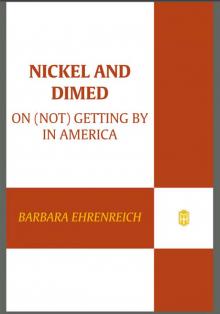 Nickel and Dimed: On (Not) Getting by in America
Nickel and Dimed: On (Not) Getting by in America Living With a Wild God
Living With a Wild God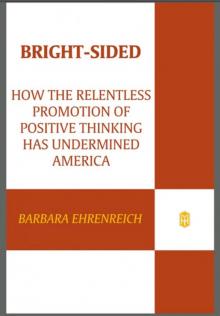 Bright-Sided
Bright-Sided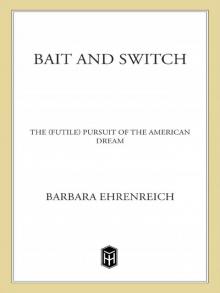 Bait and Switch: The (Futile) Pursuit of the American Dream
Bait and Switch: The (Futile) Pursuit of the American Dream Dancing in the Streets: A History of Collective Joy
Dancing in the Streets: A History of Collective Joy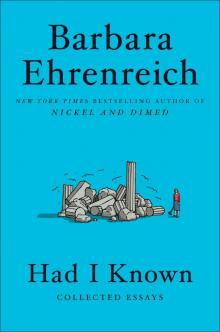 Had I Known
Had I Known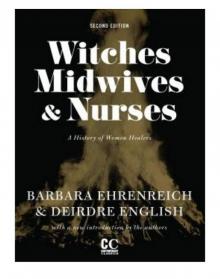 Witches, Midwives, and Nurses
Witches, Midwives, and Nurses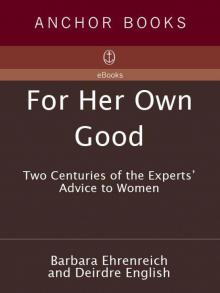 For Her Own Good: Two Centuries of the Experts Advice to Women
For Her Own Good: Two Centuries of the Experts Advice to Women Nickel and Dimed
Nickel and Dimed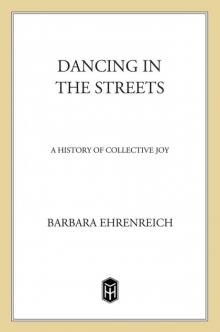 Dancing in the Streets
Dancing in the Streets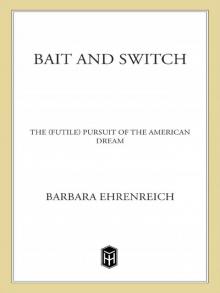 Bait and Switch
Bait and Switch